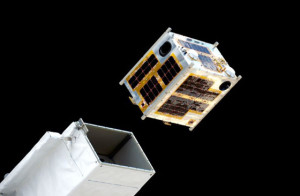DIWATA-1, the Philippines’ first microsatellite, has started its duty as the country’s eye in the sky after it was successfully launched into space on Wednesday night.
It was released into orbit around 7 p.m. from the Japanese Experiment Module (JEM), nicknamed “Kibo,” where it was housed since it reached the International Space Station (ISS) late last month.
The Japan Aerospace Exploration Agency (Jaxa) in Tsukuba Space Center said the deployment of Diwata-1 marks the first foray of a 50-kg (the size of a “balikbayan [returnee] box”) class satellite from the JEM.
Acknowledging this historical milestone, Jaxa noted that “the deployment of the microsatellite combines the only air lock and robot arm in the ISS used in ‘Kibo’ operations, which, in the future, is expected to be one of the important means to meet the launch needs of microsatellites.”
The microsatellite was released by the JEM Small Satellite Orbital Deployer at an altitude of 400 kilometers from the earth’s surface.
Its mission is to capture photos and images through its main payload consisting of high precision telescope, spaceborne multi-spectral imager and wide field camera.
The telescope produces high resolution imaging for observing large-scale weather patterns while the imager is used for monitoring bodies of water and vegetation.
The camera, on the other hand, is used in observing large-scale weather patterns.
Diwata-1 was designed, developed and assembled by Filipino scientists.
The launch marks a milestone in the country’s developing space program and a testament that local scientists can make their own microsatellite.
“The Diwata-1 might be a small satellite, but it represents the dreams and aspirations of the Philippines, as far as making space technology work for the Filipino,” said Joel Joseph Marciano, director of the Advanced Science and Technology Institute of the Department of Science and Technology (DOST), in a news conference at the Tsukuba Space Center.
“A lot of kids in the Philippines before [would] think of space as part of science fiction. But what this means is that for our young engineers and scientists in the Philippines, given enough support, they can actually achieve what first-world countries are doing with technology,” Fidel Nemenzo, vice chancellor for Research and Development of the University of the Philippines-Diliman in Quezon City, said.
Philippine Ambassador to the United States Jose Cuisia Jr. said the launch of Diwata-1 is “not only a giant leap for Philippine science and technology. It could also provide Philippine policy makers with the scientific data and information needed to formulate policies relating to disaster mitigation, agricultural productivity and management of land and water resources.”
Diwata-1 is expected to be in orbit for approximately 20 months and will be imaging the country twice daily.
Along with the microsatellite development is the installation of the satellite ground receiving station, named Philippine Earth Data Resources Observation (Pedro).
Located in Subic, Zambales, Pedro is tasked to receive Diwata-1 imagery, including other images from select commercial satellites.
Another space-related facility under construction is the UP-Diliman Microsatellite Research and Instructional facility, which will be the hub of training for future space technology research and development activities.
The Philippines’ second microsatellite, Diwata-2, will be deployed in late 2017 or early 2018.


